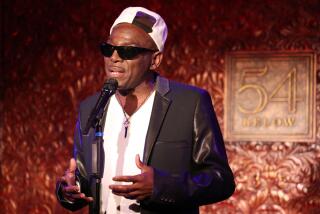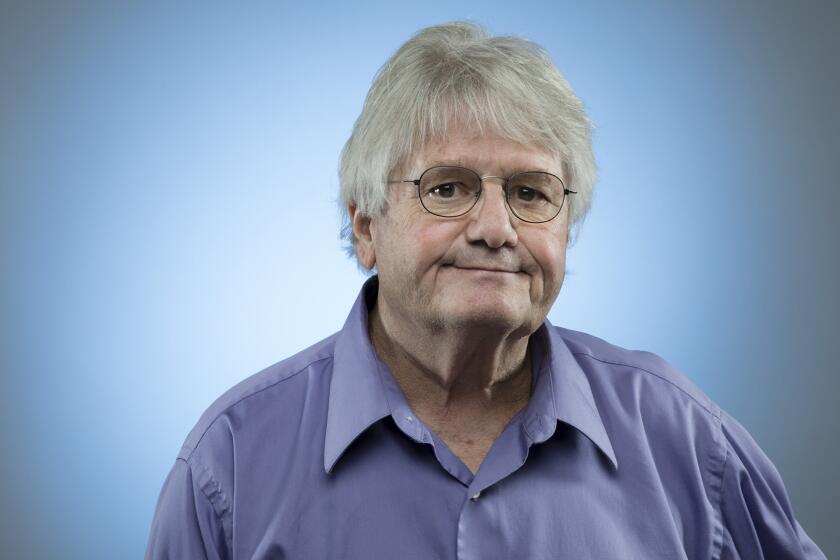From the Archives: Hollywood Giant John Huston Dies
John Huston, one of the most colorful and talented of all American film makers, died early Friday of emphysema at the age of 81.
The rugged director and actor, whose life proved as interesting as many of the characters he moved about the sets of his varied films, died in his sleep at a home he was renting in Newport, R. I., near the filming site of “Mr. North,” his last picture.
Despite the debilitating effects of his respiratory problems, which had finally confined him to a wheelchair and a supply of oxygen, the hickory-tough Huston had continued to work.
In late July he began acting in “Mr. North,” a script he co-authored with Janet Roach, who wrote his successful “Prizzi’s Honor.” The film was being directed on location in Newport by his son Danny, 25, with Huston’s daughter Anjelica co-starring. When he fell ill, Huston asked his old friend Robert Mitchum to stand by, and then to take over the role.
Huston had completed directing his last feature, “The Dead,” based on a James Joyce story from “Dubliners,” earlier this year. It is to be released in November.
And in what proved a farewell public gesture, Huston, a lifelong smoker, in June filmed a television spot for the American Lung Assn. in which he praised “the courage of those fighting diseases of the lung.”
Huston’s career began with a brief fling as an actor, following in the footsteps of his father, Walter. But after working successfully as a staff writer at Warner Bros. in the late 1930s, he found his niche as a film maker with his first directing effort, “The Maltese Falcon,” in 1941.
His films include such classics as “The Treasure of the Sierra Madre,” starring Humphrey Bogart and Huston’s father as a salty old prospector, “The Asphalt Jungle,” “Beat the Devil,” “Moulin Rouge,” “Key Largo,” “Red Badge of Courage,” “The African Queen,” “Night of the Iguana,” “Fat City” and “The Man Who Would Be King,” a great commercial success with Michael Caine and Sean Connery in the Kipling story.
The range of Huston’s interests, and achievements, was reflected in such offbeat films as “Wise Blood,” a story about religious obsession adapted from a Flannery O’Connor novella, and “Under the Volcano,” a critically admired but commercially unsuccessful telling of a Malcolm Lowry novel about the last day of a British expatriate in Mexico.
Big Success With ‘Prizzi’
“Prizzi’s Honor” in 1985, both a critical and box office success, was vintage Huston--tough, funny and characterful, a darkly comic tale (from a Richard Condon novel) of loyalties in a crime family. He was nominated for an Academy Award as best director. Daughter Anjelica, who co-starred with Jack Nicholson in the film, won an Oscar as best supporting actress for her performance. Her grandfather Walter had won as supporting actor for “Sierra Madre” many years before.
Huston was named the 1983 recipient of the American Film Institute’s Life Achievement Award. It was the latest in a long series of honors that included Oscar nominations not only as a director but as a writer and an actor. He won two Academy Awards, for writing and directing “Sierra Madre.” He was given the prestigious Laurel Award of the Writers Guild in 1964 and was the subject of an homage at the Cannes Film Festival in 1979.
A tall, thunder-voiced man who had been an amateur boxing champion in his teens and later an officer in the Mexican cavalry, Huston seemed part hell-raiser and part courtly gallant.
In 1945 he had a widely reported no-decision fistfight with Errol Flynn at David O. Selznick’s house, possibly over Flynn’s estranged wife Nora Eddington, whom Huston was escorting.
Huston himself was married five times and in his autobiography, “An Open Book,” said that his wives were, in order, “a schoolgirl, a gentlewoman, a movie star, a ballerina and a crocodile.”
Asked once how he would change his life if he had it to do again, Huston said, “I would spend more time with my children. I would make my money instead of spending it. I would learn the joys of wine instead of hard liquor. I would not smoke cigarettes when I had pneumonia. I would not marry the fifth time.”
Became Irish Citizen
In 1964 he became a citizen of Ireland, where he had lived since 1952, but gave up his country estate there in 1978, explaining that “it cost me so much to live there that I had to stay away and work all the time to afford it.” He lived most of his later years at a remote house in Mexico that was reachable only by water and leased from Indians. His house companions were said to include two boa constrictors and an ocelot.
As a film maker he was a muscular and effective storyteller with a particular gift for capturing the emotional fireworks between people, and he was not above keeping the tensions high off camera as well as on. Sardonically acknowledging this aspect of his reputation, he presented all the women in the cast of “Night of the Iguana”—Ava Gardner, Elizabeth Taylor, Deborah Kerr and Sue Lyon—with tiny pistols. But he later explained that the location was “a most serene experience.”
Huston was born in Nevada, Mo., on Aug. 5, 1906, the son of Walter Huston and newspaperwoman Rhea Gore. Huston liked to say that his grandfather had won the town in a card game. The elder Huston, at his wife’s insistence, had detoured from vaudeville and theater into something more stable and was working for the local power company.
When he was 3, his parents separated, Walter returning to New York and the theater and the boy dividing his time between father and mother. He had a serious illness as a child and was in a sanitarium. He attended a military school and then Lincoln High in Los Angeles, which he chose, he said later, because it had the best boxing team in the city. Huston briefly was California state lightweight amateur boxing champion.
Huston’s father invited him to come to New York and try his hand at acting. He did, landing a small role in the Provincetown Theater’s production of Sherwood Anderson’s “Triumph of the Egg,” but he decided he really didn’t like acting.
Already an accomplished horseman, Huston enlisted in the Mexican army and spent two years, emerging at 21 as a lieutenant of cavalry. He returned to New York and tried his hand at writing. His play for puppets, “Frankie and Johnny,” was produced in the 1929 season. He also wrote stories for American Mercury magazine.
In 1930 Huston went to Hollywood with his father and received his first screen credit, for additional dialogue, on “A House Divided,” directed by William Wyler and starring Walter. He earned a similar credit on Bela Lugosi’s “Murders in the Rue Morgue.” Huston’s first solo credit was on “Law and Order,” which also starred his father.
But, still restless, Huston quit Hollywood and took off for Europe, where he flirted with starvation in London and Paris, eking out a living doing sidewalk sketches. A friendly lady of the evening, he liked to say, loaned him the fare to return to the United States.
Back to Acting
Home again, he turned once more to acting, touring with a company of “Abraham Lincoln.”
What was to become an extraordinary film career began in 1937 in earnest when he signed a contract as a Warner Bros. writer and in quick order worked on the scripts for “Jezebel,” “Dr. Ehrlich’s Magic Bullet,” “The Amazing Dr. Clitterhouse,” “Juarez,” “Sergeant York” and “High Sierra.” He received his first two Academy Award nominations for the scripts of “Dr. Ehrlich’s” and “Sergeant York.”
Warners promised Huston that if “High Sierra” proved to be profitable he could both write and direct a film of his own. It was, and Huston elected to do Dashiell Hammett’s “The Maltese Falcon,” which he made in two months for $300,000. It established Huston’s reputation as a director, did more than any other single film to create the Humphrey Bogart mystique and, with its memorably vivid supporting cast—Sidney Greenstreet, Peter Lorre and Mary Astor—it has remained one of the most popular of all American films. Huston received another Oscar nomination for his script.
After two more films, Huston joined the Army as a documentary maker. The three films he made for the Army—”Report From the Aleutians,” “Battle of San Pietro” and “Let There Be Light”—are now recognized as classics.
“San Pietro,” his account of the infantrymen’s bloody struggle to capture an Italian hill town, was photographed by six life-risking cameramen and has a grim authenticity that no fictional war film has yet matched.
Pentagon Suppressed Film
“Let There Be Light,” about the treatment of battle fatigue victims, was suppressed by the Pentagon for more than three decades after the war, on grounds that it was bad for morale, despite its essentially optimistic view of the chances of full recovery.
After the war Huston did a film for Warners (“Three Comrades”), then directed Jean-Paul Sartre’s “No Exit” on Broadway. Back in Hollywood yet again, he won his Academy Awards, for “Sierra Madre” from a novel by the mysterious B. Traven. The film was nominated for best picture but lost to Laurence Olivier’s “Hamlet.”
The 1950s were a productive and important time for Huston. After “Key Largo” (in which Claire Trevor won an Oscar as best supporting actress), Huston split with Warner Bros. At MGM he made two remarkable films, the tough crime drama “The Asphalt Jungle” and the poetic adaptation of Stephen Crane’s Civil War story “Red Badge of Courage.” The making of the film, amid horrendous studio pressures, was chronicled in Lillian Ross’ book “Picture.”
Then, newly partnered with Sam Spiegel, a colorful entrepreneur who once called himself S. P. Eagle, Huston in 1951 made his unforgettable “The African Queen,” for which Bogart won his only Oscar, as best actor. Katharine Hepburn, James Agee’s script and Huston’s direction were also nominated.
Advice to Hepburn
In her just released memoir, Miss Hepburn wrote that Huston told her the key to her role as a repressed spinster was to “play it like Eleanor Roosevelt.” She said it was the “best piece of direction I have ever heard.”
Huston’s next film, “Moulin Rouge,” was notable for its experimental approach to color, Huston having hired a Life magazine photographer, Eliot Elisofon, as a special consultant. “Beat the Devil,” which Huston co-authored with Truman Capote and which starred Bogart in a sort of spoof of the “Maltese Falcon” genre, took a beating from the critics in 1954 but has since emerged as a cult film that was ahead of its time.
Huston’s other work in the period included “Moby Dick,” with its Ray Bradbury script and Gregory Peck as Captain Ahab, and “Heaven Knows Mr. Allison” and “The Misfits,” with Marilyn Monroe and Clark Gable, whose last film it proved to be.
His “Freud” in 1962, with Montgomery Clift, received indifferent reviews, as did his clever mystery “The List of Adrian Messenger” in 1963.
Huston returned to acting, playing a cardinal for Otto Preminger in “The Cardinal” in 1963, and he interspersed directing and acting thereafter, although he continued to insist, “I’m not an actor,” meaning that he was first and always a director. His cardinal won him an Academy Award nomination for best supporting actor.
He played Noah and was also the narrator of his epic-sized “The Bible,” which was 19 months in production but commercially unsuccessful.
Bogart’s Assessment
Bogart once said that Huston, with his craggy face and misshapen nose, “has more color and is more photogenic than 90% of the actors in Hollywood.”
Huston’s work in the 1960s and ‘70s varied between films that appeared mostly to keep him in horses and foxhounds in Ireland and others, like “Reflections in a Golden Eye,” that confirmed him as an adventurous master of the film form.
“Fat City” in 1972, although a box office flop, was a beautifully observed story of small-time professional boxers destined never to make the big time. The Los Angeles Times review said the film confirmed that “out of his own early meanderings, Huston knows drifters, hustlers, losers, soiled ladies, small towns, side streets, the smells of dust, sweat, fear and failure and the metallic taste of your last thin dime.”
Stacy Keach, the star of that film, on Friday called Huston “a king among men. No man inspired me more and no man gave me more. . . .”
Of Huston’s film of Rudyard Kipling’s “The Man Who Would Be King,” with Michael Caine and Sean Connery as ex-British Army pals who find themselves a kingdom to call their own, The Times review said it revealed the best of the Hollywood legacy: “The exotic grandeur, the teeming populations of extras, the muscular dash, the larger than life romantic bravura and the confident creative style.” It revealed, accordingly, the best of Huston.
‘Chinatown’ Performance
“While living I thought he was a legend,” Caine said after he learned of Huston’s death. “And now he is.”
Huston gave one of his finest performances as an actor in Roman Polanski’s “Chinatown,” playing Faye Dunaway’s tyrannical and incestuous father. He also created vivid characters in “The Wind and the Lion” and “Winter Kills.”
He suffered a near-fatal aortic aneurysm in 1977, requiring emergency surgery and a second operation to relieve an abdominal blockage. His closest friends presumed that even if he survived, his professional life was over. But he recovered to direct one of his most interesting films, “Wise Blood,” from Flannery O’Connor’s novel about a young man fatally obsessed by religion. Huston himself played an old-time tent-preaching evangelist.
Huston’s first marriage, in 1927, was to a childhood sweetheart, Dorothy Jeanne Harvey, in Los Angeles. They were divorced in 1933, and he next married an English woman, E. Lesley Black, who divorced him in 1945. The next year he married actress Evelyn Keyes, who left him in 1949, complaining among other things that his dogs, cats and monkey gave her hay fever.
Father of Four
He and Keyes were divorced in 1950 and the next day he married ballerina Enrica (Ricky) Soma. She was killed in an auto accident in France in 1969. He married his fifth wife, Celeste Shane of Beverly Hills, in 1972. They were divorced in 1975.
He had four children, Anjelica, Tony, Danny and Allegra.
Although he began his film career as a writer, Huston once told The Times’ Cecil Smith, “I hate writing. The man alone with his pencil. I hate the discipline of it, the technical limitations. I’m not sure any writer—except a bad writer—likes to write.”
And he continued to work as actor and film maker.
“For me,” Huston said, “life has been such an occasion; really, such an occasion.”
His body is being returned to Los Angeles, where a private memorial service has been scheduled Monday.
Lauren Bacall, who taught Humphrey Bogart how to whistle, dies at 89
From the Archives: Classy Film Feminist Had Brains, Beauty, That Voice
From the Archives: John Wayne Dies at 72 of Cancer
From the Archives: Marilyn Monroe Dies; Pills Blamed
Ricardo Montalban dies at 88; ‘Fantasy Island’ actor
More to Read
Start your day right
Sign up for Essential California for the L.A. Times biggest news, features and recommendations in your inbox six days a week.
You may occasionally receive promotional content from the Los Angeles Times.






